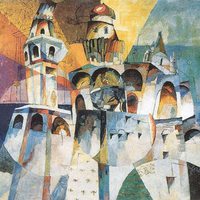Symbolism arose at the turn of the XIX – XX centuries as one of the directions of European art culture. Artists working in this style endow their paintings with hidden philosophical and mystical meanings. When painting, they contrast reality with a world of visions and dreams.
Of particular importance in the paintings are mysterious signs. The solution to their mystical meaning requires deep immersion in the process of understanding the plot of the picture. Symbolism has such traits as understatement and introspection.
The history of the development of symbolism
Images of mysterious signs were used in the design of monumental structures in ancient Egypt, Babylon and in antiquity. Traits of symbolism can be seen in ancient Christian icons. The icon painters gave a deep meaning to the face of the saints with the help of obvious symbols. Among them are halo, bowls, holy books, pigeons, keys to paradise, palm branches and crosses.
Many religious and mythical themes are in the paintings of Renaissance artists. A striking example of this style of painting is the triptych of the Dutch painter Jerome Bosch. There are still debates between art historians from different countries over the secret meaning of this work of art. In the still lifes of Dutch painters, such objects as extinct candles, wilted flowers, skulls carried a secret semantic load. The masters of still life in the genre of symbolism include David Bailly, Harmen Stenwijk, Jan Davidas de Hema.
In landscapes, traits of symbolism began to appear in the works of artists at the turn of the 18th – 19th centuries. The cradle of the formation of symbolism as a separate direction in painting was European romanticism. Its bright representative is the German artist Caspar David Friedrich. In his works, the master used simple and understandable symbols for the viewer. The difference between romanticists and symbolists is a different approach to finding a spiritual beginning. The former sought him in the inner world of man, and the latter in absolute Being.
The author of the term "symbolism" is considered to be the French poet Jean Moreas. For the first time, the term was used in the poet’s manifesto, written by him in 1886. Many of the artistic means used by the Symbolists in the creation of their paintings were borrowed from modernist movements. Characteristic features of symbolism are the cults of beauty and mystery. This direction is inherent in:
- notes of a decadent mood in the plots of paintings;
- rejection of reality and craving for unattainable ideals;
- searches for new expressive images.
Each symbol used in the canvases of artists working in this direction has a certain meaning:
- number 7 - a sign of the completion of something (7 colors of the rainbow, 7 deadly sins or days of the week);
- owl - symbolizes wisdom, death or sleep;
- Olive branch is a sign of peace.
The Symbolists' pure soul is always associated with the image of the baby, and the hourglass in their paintings hinted at the frailty of being. Great interest in symbolism at the turn of the XIX – XX centuries. manifested in many countries of Europe, including Russia, Poland and England. The symbolist ideas found their continuation in the future in surrealism and modernity.
Famous Symbolist Artists
Many masters who entered the cohort of greats worked in the direction of symbolism. Among the most famous of them:
- Gustave Moreau (1826–1898). The French artist is a vivid representative of symbolism, although he himself did not refer to the masters working in this direction of painting. Theophile Gautier characterized his manner of writing pictures as strange, unusual for the eyes, but thoughtful and intended for a refined spirit. The artist’s debut in the field of symbolism is his painting “Oedipus and the Sphinx”, exhibited by him in 1864 at the Salon in Paris.
- Pierre Cecile Puvi de Chavannes (1824–1898). French artist. The first works of Puvis de Chavannes, which he began to exhibit in the salon since 1850, were not successful with the public. Wide popularity came to him only in 1861 after he wrote the paintings “War” and “Peace”, and the real success brought him the creation of two compositions “Hope” (1871 and 1872).
- George Frederick Watts (1817–1904). British painter and sculptor. A significant place in his work was occupied by monumental allegorical paintings. Characterizing his work, he noted that he draws ideas, not things. During his lifetime, the artist was best known for his two paintings: “Hope” and “Love and Life”. Contemporaries called Watts English Michelangelo for his commitment to the traditions of the old Italian masters.
- Fernan Knopf (1858–1921). Belgian Symbolist. Included in a cohort of recognized masters of mystical fantasies. Writer, art critic. Knopf's works are distinguished by the accuracy of the composition. Not a single detail of the picture was depicted by the artist by accident. Many of them have female images.
- Mikhail Vrubel (1856–1910). The great Russian artist, best known as an icon painter. The central image of Vrubel painted paintings in the style of symbolism is the Demon. Contemporaries of the artist saw in him a symbol of the fate of a Russian intellectual-romantic, trying to unsuccessfully escape from the ugly surrounding reality.
Other prominent representatives of the direction of symbolism in painting include the Italian artist Giovanni Segantini, the Swiss Arnold Beklin, the Norwegian Edward Munch and the Austrian Alfred Kubin.

